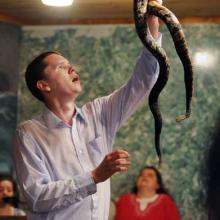national geographic
Mason found that the magazine virtually ignored people of color in the U.S. until the 1970s who were not laborers and domestic workers, and consistently perpetuated people of color from foreign lands as "exotics, famously and frequently unclothed, happy hunters, noble savages—every type of cliché."

Image via HelenField/Shutterstock.com
There’s nothing wrong with celebrating human ingenuity and determination, but the approach here is simplistic. It may well be true that settlements on Mars are the only hope for our species to continue, and should humanity pursue this course, acts of heroism may well be required. But going about this endeavor the right way must involve a healthy dose of self-reflection, and in this regard Mars has missed an opportunity. For one thing, despite the message that expansion to Mars is imperative for the survival of the human race, there is no discussion of the human contribution to our planet’s eventual uninhabitability. It’s possible that Earth could be hit by a sizable asteroid, or that a super volcano could erupt, but anthropogenic climate change and nuclear warfare pose far greater threats to our flourishing over the next few centuries. If we are going to switch planets in order to save ourselves, we can’t ignore the fact that we bring our destructive power with us.
I caught up with executive producers McCreary, James Younger, and Moran Freeman on the red carpet premiere of The Story of God in New York City.
“People don’t see the commonalities between religions,” Younger explained. “They just think of their faith as being the one that has the answers. Other faiths? They don’t know two things about them.”
It may be as close as a person can get to praying at the Church of the Holy Sepulchre, the Al-Aqsa Mosque and the Western Wall, without actually going there.
The newly released movie “Jerusalem,” filmed in 2D and 3D and playing on IMAX and other giant-screen theaters across the U.S. and the world, gives viewers grand, hallmark panoramas, at once awe-inspiring and intimate.
For years filmmakers had sought the rights to capture the city from the air, but never before had permission been granted, in part because the holy city is a no-fly zone.
Still, before filming began in 2010, producer Taran Davies came up with an extensive wish list of all the sites and rituals he wanted in the film, and presented it to advisers familiar with the spectrum of religious and secular officials who would have to approve.
“They all laughed and said forget about it,” Davies said. “They said, ‘It’s impossible and you’re not going to get half of what you’re looking for.’”
A Tennessee pastor’s dangerous spiritual practices made him a star of a reality TV series.
Now they may make him a religious liberty crusader.
Officials from the Tennessee Wildlife Resources Agency raided the Tabernacle Church of God in LaFollete last Thursday and seized 53 venomous snakes — including timber rattlesnakes, copperheads, and several exotic breeds.
They cited the Rev. Andrew Hamblin, the church’s pastor and co-star of the National Geographic series Snake Salvation, and plan to charge him with 53 count of violating a state ban on possessing venomous snakes at a court hearing on Friday. Each count carries a maximum sentence of one year in jail.
Since the ban on international trade of ivory in 1989, the ivory black market has been on the rise, and a National Geographic investigation found that demand for religious art pieces carved out of the precious material has played a considerable role.
“No matter where I find ivory, religion is close at hand,” said investigative reporter Bryan Christy, whose article, “Ivory Worship,” is included in the new edition of National Geographic magazine, released Sept. 14.
“Elephant poaching levels are currently at their worst in a decade,” Christy wrote. The Convention on International Trade in Endangered Species of Wild Fauna and Flora (CITES) estimates that at least 25,000 elephants were poached in 2011, mostly for their ivory tusks.
Philippine Catholics use ivory to construct crucifixes, figures of the Virgin Mary and other icons. The province of Cebu is particularly known for its ivory renditions of the Santo Nino de Cebu (Holy Child of Cebu), used in worship and celebration.
 With the scandal around Rupert Murdoch growing by the day, a full-fledged boycott of News Corp. has been launched on the internet, according to the Washington Post.
With the scandal around Rupert Murdoch growing by the day, a full-fledged boycott of News Corp. has been launched on the internet, according to the Washington Post.
The website Boycott Murdoch also has Facebook and Twitter pages. While the boycott has received coverage on many mainstream news outlets, it has yet to gain much traction. The Facebook page has less than 700 fans and the Twitter page is approaching only 1,000 followers. To make even a small dent in Murdoch's bottom line, the boycott will need to metastasize, and quickly.
Hackers. Slow Motion. Snow. Here’s a little round up of links from around the web you may have missed this week:
- Random Hacks of Kindness: a two-day competition of more than 1,000 software engineers solving problems that arise during humanitarian crises.
- Marvel at some of the entries to National Geographic’s photography contest.
- Restaurateur Jean-Gorges Vongerichten’s half-Korean wife, Maria Vongerichten, has a new PBS show called “The Kimchi Chronicles,” in which she eats her way through South Korea.
- What happens when you put a slow-motion camera on a fast moving train? Watch.
- What did people google search in 2010? (Also, in list form.)
- Have you had your first snow of the year yet?
- Jim Wallis says it best: DREAMS should not be illegal.




